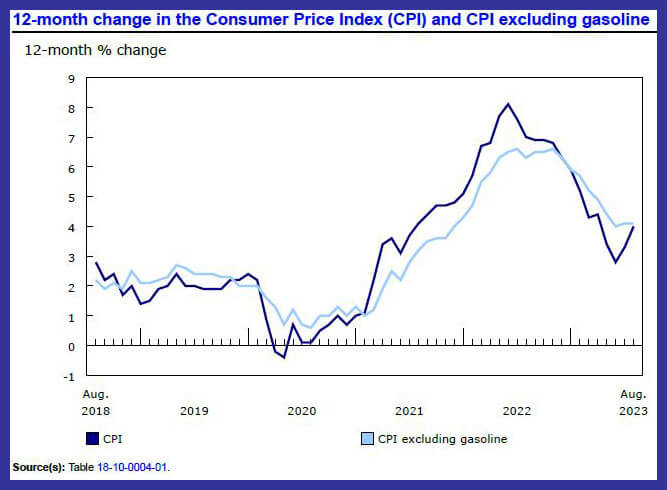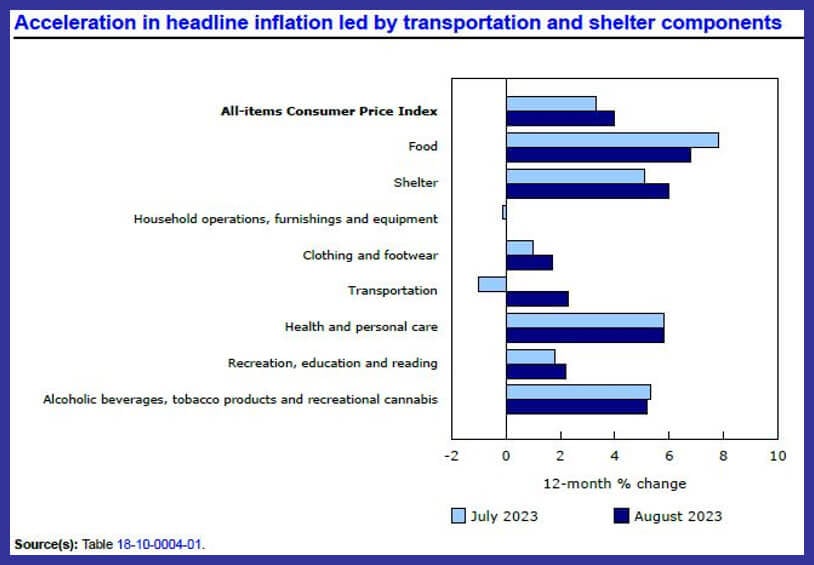Making sense of the markets this week: September 24, 2023
Inflation ticks up in August, the U.S. Fed decides not to raise rates, IPOs make a comeback, what the UAW strike means for markets and investors.
Advertisement
Inflation ticks up in August, the U.S. Fed decides not to raise rates, IPOs make a comeback, what the UAW strike means for markets and investors.

Allan Small, Senior Investment Advisor at the Allan Small Financial Group with iA Private Wealth, shares financial headlines and offers context for Canadian investors.
Canada’s annual inflation rate jumped to 4% in August, up from 3.3% in July—the highest since April this year, when it hit 4.4%.

This was not a surprise to anyone. Higher oil and shelter prices were behind most of the inflationary pressure. Gasoline prices at the pump were up 0.8% year over year (YOY) in August, compared to a fall of 12.9% in July. This was the first annual increase since January 2023. Rents were also up 6% year over year in August while mortgage rates surged 30.9% YOY.
What Canadians may have been surprised to learn is that food prices—a topic that’s received the most media attention—had a smaller increase than in July, so food inflation is slowing. According to Statistics Canada, annual food costs rose 6.9% in August, a smaller increase than July, when they were up 8.9% YOY.

Core inflation (the change in prices of goods and services not including food and energy) is sitting at 3.6% in Canada—up slightly from 3.4% in July.
By comparison, the annual Consumer Price Index (CPI) in the U.S. was 3.7% in August, while core inflation was 4.3%, down from 4.7% in July.
In all cases, inflation is still well above both the Bank of Canada’s and the U.S. Federal Reserve’s stated 2% targets. However, for both sides of the border, inflation is also significantly lower than when both central banks started raising interest rates to keep inflationary pressures in check.
That said, I think three main factors brought down inflation over the past 18 months and I believe higher interest rates were not the main one. In my opinion, lower oil prices, workers returning to the labour force after the “COVID exodus,” and a reopening of global supply chains, have all led to lower inflation rates and allowed central banks to negotiate somewhat of a soft landing for the economy.
That’s why I hope the Bank of Canada (BoC) does not raise interest rates again. I think Canadians are feeling the economic pinch, even if it isn’t necessarily showing up in the macro data we’re receiving—at least not yet.
On a day-to-day basis, Canadian consumers are struggling with higher debt payments. They have less money to spend and are keeping discretionary costs to a minimum, which is hurting businesses. Anecdotally, I’m seeing people tap into their savings to pay down their high-interest debt. This will only get worse if the BoC continues to raise rates and we enter into a recession. If that were to happen, and we go from an interest-rate hiking cycle to an interest-rate cutting cycle, whatever credibility the BoC has will go out the window.
The Canadian central bank has acknowledged that while its priority is inflation—even at the risk of an economic slowdown—it recognizes it’s walking a fine line. For myself, I’d rather have 3% inflation with close to full employment than fight tooth and nail to get inflation down to 2% and put people out of work. To me, that tradeoff is not worth it.
Slide the columns right or left using your fingers or mouse to see even more data, including June, July and August.
| January 2023 | February 2023 | March 2023 | April 2023 | May 2023 | June 2023 | July 2023 | August 2023 |
| CPI 5.9%Core CPI 4.9% | CPI 5.2%Core CPI 4.8% | CPI 4.3%Core CPI 4.5% | CPI 4.4%Core CPI 4.4% | CPI 3.4%Core CPI 4.0% | CPI 2.8%Core CPI 3.5% | CPI 3.3%Core CPI 3.4% | CPI 4.0%Core CPI 3.6% |
| February 2023 | March 2023 | April 2023 | May 2023 | June 2023 | July 2023 | August 2023 |
| CPI 6.0%Core CPI 5.5% | CPI 5.0%Core CPI 5.6% | CPI 4.9%Core CPI 5.5% | CPI 4.0%Core CPI 5.3% | CPI 3.0%Core CPI 4.8% | CPI 3.2%Core CPI 4.7% | CPI 3.7%Core CPI 4.3% |
I was always of the view that the U.S. Federal Reserve would stand pat and not raise interest rates this month. And that’s what happened. At this point, I think there’s less than a 50% chance it will raise them at its next meeting in November. I’m not alone. Many economists, analysts and investors believe this will be the case.
For his part, Federal Reserve Board Chair Jerome Powell’s tone remains hawkish, encouraging people to continue to spend conservatively. He is unwavering in his commitment to lowering inflation to 2%.
What does this mean for the stock market?
Not much, as large publicly listed companies are better equipped to handle a slowing economy than smaller companies. My worry today is for the small businesses that simply don’t have the resources to invest in technologies, like artificial intelligence (AI), which can help them drive efficiencies and grow. But, these aren’t the companies listed on stock exchanges.
For investors, this is still a good time to buy stocks. The S&P 500 is up 16% year to date even with slower growth. While there is still talk of a recession, it hasn’t happened yet. In fact, that talk of a recession has been pushed further out. North American investors, particularly those invested in U.S. stocks, have fared well.
What does concern me is the Fed’s reliance on what it calls “super core CPI data,” –which excludes volatile food, energy and shelter prices—when determining policy. While I understand taking out costs that consumers can’t control—after all you don’t want to raise interest rates multiple times in response to Saudi Arabia and Russia cutting oil production to drive up prices—at the same time we also know energy prices leak into all aspects of the economy. They simply cannot be ignored. Oil is a cost of doing business in every industry and sector.
After an almost non-existent IPO market in 2022, British computer-chip maker Arm raised US$4.87 billion with its initial public offering—giving the company that powers most of the world’s mobile smartphones a valuation of USD$54.5 billion. It was the largest IPO of 2023 and was followed by another tech IPO for grocery delivery startup Instacart, which wants to raise more than USD$600 million.
It’s not just tech companies looking to go public. The nearly 250-year-old German sandal maker Birkenstock is expected to make its debut on the New York Stock Exchange in October.
In general, IPOs are good news for investors because they indicate confidence in the stability of the markets and can represent a good opportunity to grow your portfolio. That said, I prefer to take a wait-and-see approaching before making a decision about whether to invest. For example, in the case of Arm, there was a lot of hype around the stock and it skyrocketed for its debut on the Nasdaq. Two days later, the stock was down 4%.
Where does it go from here? No one knows yet.
It’s important not to get swept up in the euphoria of the moment and buy something at all costs. There is always a right price to anything. Make sure the price and valuation make sense when you decide whether or not to invest in an IPO.
For the first time in its history, the United Auto Workers Union in the U.S. launched a simultaneous strike involving 12,700 workers against the Big Three Detroit automakers—Ford, General Motors and Chrysler-parent Stellantis—targeting one U.S. assembly plant at each company. Ford was able to reach a tentative deal with Unifor, representing 5,600 Canadian auto workers, which could avoid a total strike in Canada.

In the U.S., workers asked for a 40% wage increase over four years, a 32-hour work week with compensation for a 40-hour work week. Canadian demands were less specific but similar in nature: substantial wage increases, improved pensions and job security guarantees.
At the time of writing this column, negotiations were still in play and the markets and economy were not impacted. Stock prices for each of the automakers dipped slightly but have been at the low end of their range trading at single-digit multiples for quite some time.
This could change if the strike continues for an extended period of time. Already there is talk of layoffs. On day four of the strike, Ford sent 600 workers home, and General Motors warned it may have to lay off 2,000 workers if the strike continues. This could lead to limited inventory, driving up prices for new and used cars, increasing inflationary pressures more broadly and dampening the U.S. economy.
Share this article Share on Facebook Share on Twitter Share on Linkedin Share on Reddit Share on Email